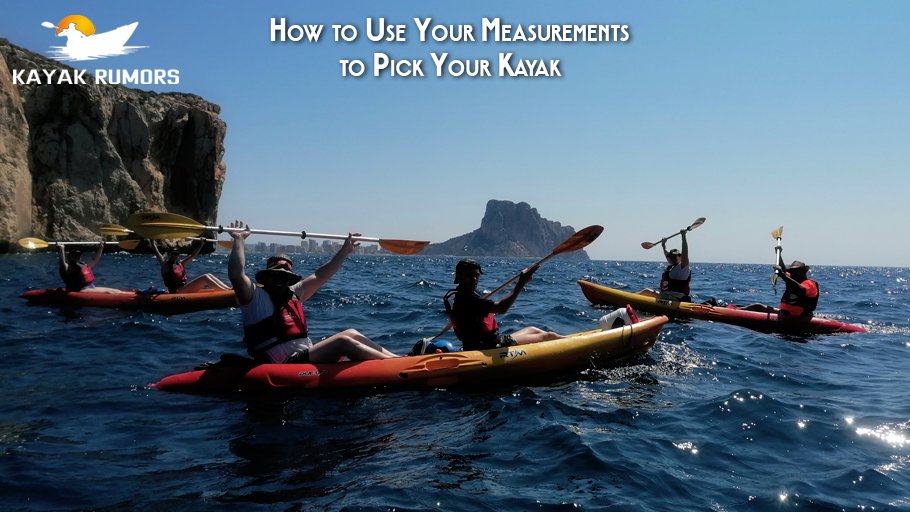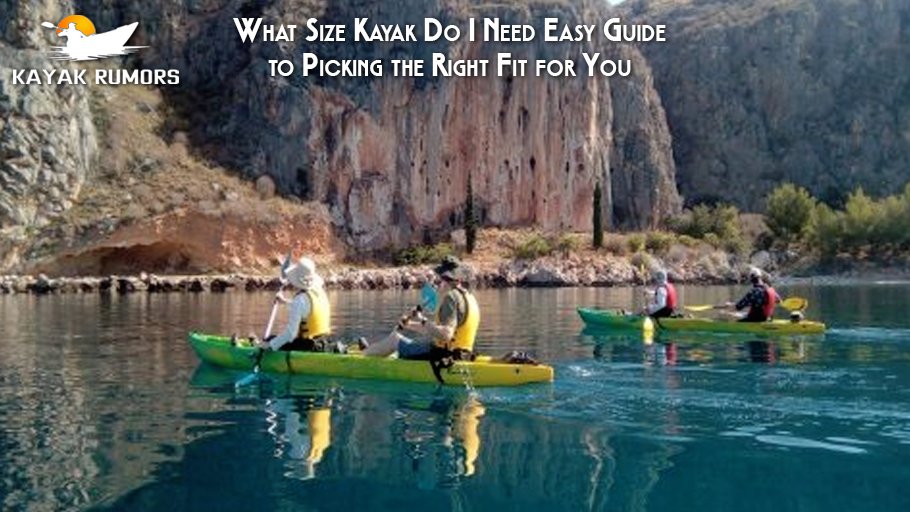If you’re asking what size kayak do I need, this guide is for you. Getting the right kayak size makes a big difference: in safety, comfort, speed, and how much fun you’ll have on the water. By the end of this post, you’ll feel confident picking a kayak that fits your height, weight, type of kayaking, and gear needs.
Here at Kayak Rumors, we’ve tried many kinds of kayaks—on lakes, rivers, coastal waters—and helped others choose. This guide combines expert tips and real-world experience so you don’t end up regretting your choice.
Key Factors to Consider When Deciding What Size Kayak Do I Need
When deciding what size kayak do I need, you need to think about several things. Each factor affects how your kayak performs and how comfortable you’ll be.
Height, Weight, and Body Shape
- Your weight plus any gear matters. Check kayak weight capacity—not just your body weight but also what you’ll carry (backpack, cameras, fishing gear, etc.).
- Taller people need more length for legroom; shorter folks need a cockpit that doesn’t squeeze knees.
- The shape of your torso and shoulders affects comfort; even people with same height might need different kayak widths or cockpit sizes.
Type of Water and Usage
- Calm lakes, gentle rivers: smaller, stable kayaks are usually fine.
- Whitewater or fast flowing rivers: shorter, more maneuverable models are better.
- Open water or long distance (touring, sea kayaking): longer kayaks with good tracking help you go farther with less effort.
Length vs. Stability vs. Maneuverability
- Longer kayaks track better (they go straight easily) and are faster in calm or open water.
- Shorter kayaks turn more easily and are handy in tight areas or when you need quick response.
- Width contributes stability. Wider kayaks feel more stable side-to-side, which helps beginners and fishing angles. Narrower ones cut through water more easily but may feel less stable at first.
Volume and Weight Capacity
- Volume = how much space the hull has. More volume means more buoyancy, which matters if you are heavy or carry gear.
- Never load a kayak to its maximum weight capacity; leave some margin for safety and handling.
Transport, Storage, and Portability
- Can you carry the kayak to the water alone?
- Roof racks, trailers, or vehicle size? A long kayak might be hard to load or store.
- Where will you store it? Garage, shed, or somewhere outside? Space influences what size makes sense.
Skill Level and Comfort Preferences
- If you’re new, a stable, wider kayak with forgiving features is more important than speed.
- If you paddle often and have experience, you may prefer a kayak that offers better speed or efficiency even if it demands more balance.
- Seat comfort, footbraces, cockpit shape all affect how long you can paddle without discomfort.
Typical Kayak Sizes: Length, Width, and Uses
To answer what size kayak do I need, it helps to know what sizes different kayak types usually come in—and why.
| Kayak Type | Approximate Length | Approximate Width | Best For |
|---|---|---|---|
| Recreational / Day‑tripping | 8‑12 ft | 28‑34 in | Casual paddling, lakes, calm rivers. Stable, easy to handle. |
| Touring / Sea Kayaks | 12‑20 ft | 18‑28 in | Long trips, coastlines, open water. Better glide. |
| Fishing Kayaks | 10‑16 ft | 30‑40 in | Stability, gear storage, casting. Wider and more stable. |
| Whitewater / River Kayaks | 6‑10 ft | 20‑28 in | Rapids, tight turning, fast water action. Shorter, more responsive. |
| Tandem Kayaks (2 persons) | 10‑16 ft | 32‑40 in | Paddling with partner or child; more room needed. |
| Inflatable Kayaks | 8‑18 ft | 30‑40+ in | Paddling with a partner or child; more room needed. |
These are general guides; your ideal size may be smaller or larger depending on your personal needs.
How to Use Your Measurements to Pick Your Kayak

Here’s a step‑by‑step way to figure out what size kayak do I need, using your own body and gear.
Step 1: Measure Yourself and Your Gear
- Measure your height.
- Weigh yourself with the gear you plan to bring (clothes, supplies).
- Note your torso height (seat to top of your head) if possible.
Step 2: Choose Based on Purpose
- What kind of kayaking do you plan to do most often?
- How long are your trips? Hours or days?
- Are there waves, currents, rapids?
Step 3: Match to Capacity and Sizes
- Use charts (like those above) to see what kayak length & width match your weight plus gear.
- Make sure kayak’s weight capacity is above your total (you + gear + allowances). Leave safety margin (e.g. 20‑30% below max load).
Step 4: Try It If You Can
- Sit in the kayak (if possible). Check knee room, foot brace positions, back support.
- See if you can manage carrying and loading it.
- If renting or borrowing, test different sizes.
Common Mistakes People Make When Figuring Out What Size Kayak Do I Need
Knowing what not to do can be just as helpful as knowing what to do.
- Choosing based only on cost or what looks good, ignoring fit and capacity.
- Going for a kayak simply because it’s “longer = faster” without thinking about transport or turning.
- Overloading the kayak (taking too much gear) makes it sit low and perform poorly.
- Buying a kayak that’s too wide or too narrow for your body affects comfort and control.
- Underestimating the difficulty of loading, carrying, and storing a larger kayak.
Examples: Best Sizes by Situation
Here are some specific recommendations depending on your size and situation, to help answer what size kayak do I need more precisely.
| Your Height / Weight | Best Kayak Length & Width | Notes |
|---|---|---|
| Under 5′6″ / under ~60 kg | 8‑10 ft, width around 28‑32 in | Recreational type for calm water, good stability. |
| 5′6″–5′10″ / 60‑80 kg | 10‑13 ft, width 28‑34 in | More flexibility; day‑touring or fishing styles may work well. |
| Over 5′10″ / over ~80 kg | 12‑16 ft or more, width 30‑36 in | Need more volume, legroom; gear capacity matters. |
| Frequent long trips / open water | 14‑18 ft, narrow hull | Better glide; speed improves. Need experience. |
| Whitewater paddling or tight rivers | 6‑10 ft, width 24‑28 in | More response, easier turning, less drag. |
Frequently Asked Questions (FAQs)
Here are common questions people have when wondering what size kayak do I need, with clear answers.
Q1: Can I use one kayak size for different types of water (lake, river, sea)?
Yes and no. If your trips are mostly similar (for example lakes and mild rivers), one kayak of moderate length (around 10‑13 ft) works well. But for sea or rough water vs whitewater, you’ll likely need different kayak styles because what works best in one may feel awkward or unsafe in another.
Q2: What if I’m in between sizes? Should I choose larger or smaller?
If in doubt, often choosing slightly larger helps with room and gear. Just be ready for some trade‑offs: bigger means harder to turn and harder to transport, but more comfort and capacity.
Q3: Does kayak width matter more than length sometimes?
Yes. For stability, comfort, especially if you’re a beginner or carry gear, width plays a huge role. Even a longer kayak that’s narrow might feel unstable if you are used to wider boats.
Q4: How much extra weight should I plan for gear?
Gear adds up fast. Plan for at least 15‑30 % extra weight beyond your body weight (clothes, safety gear, food, water). If you camp or fish, even more. Make sure kayak capacity covers everything.
Q5: How do I know if the kayak I choose will perform well?
Look at reviews, test it if you can. Check tracking (does it go straight), stability, speed, and comfort. If you can paddle similar models or rentals, compare those to your chosen size to get a feel.
Helpful Resources to Nail Your Choice
To learn more and compare models, these sources are useful:
- WatersportsWhiz – What Size Kayak Do I Need: Detailed article with length‑to‑beam ratio, volume charts, examples. WaterSportsWhiz
- TrickyFish – Kayak Sizing Guide: Covers different kayak types and how to pick the size based on your body and style. Trickyfish
- Water Diversions – What Length Kayak to Buy: Reviews touring, fishing, and inflatable kayaks with real size ranges. waterdiversions.com
These will help you compare real kayak models and dimensions before buying.
Conclusion: Pick the Size That Fits You Best
Deciding what size kayak do I need means balancing many things: your body size, where you will paddle, how much gear you carry, and how often you paddle. Probably the most important thing is that your kayak feels good to sit in and control, not just looks nice on paper.
If you use the guidance here—measures, the type of kayaking you do, checking capacity, testing if possible—you’ll end up with a kayak that fits and allows you to enjoy your time on water more.
Final Call to Action
If you’re ready to find the right kayak size, explore Kayak Rumors’ recommended models with real‑world sizes, specs, and user feedback. Compare options, see what matches your measurements, and make your purchase confidently. Start with our size calculator or model comparison chart now—find the kayak size that fits you.



